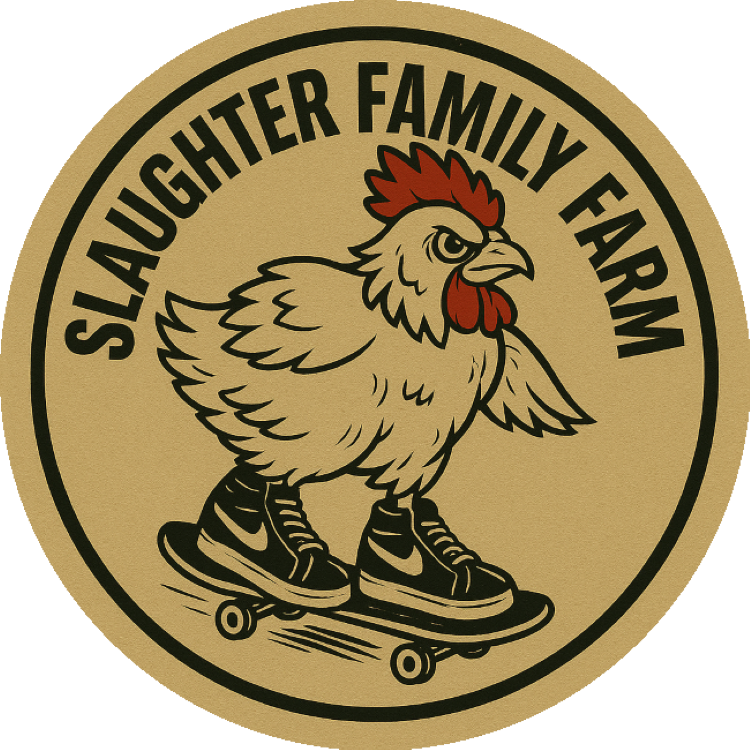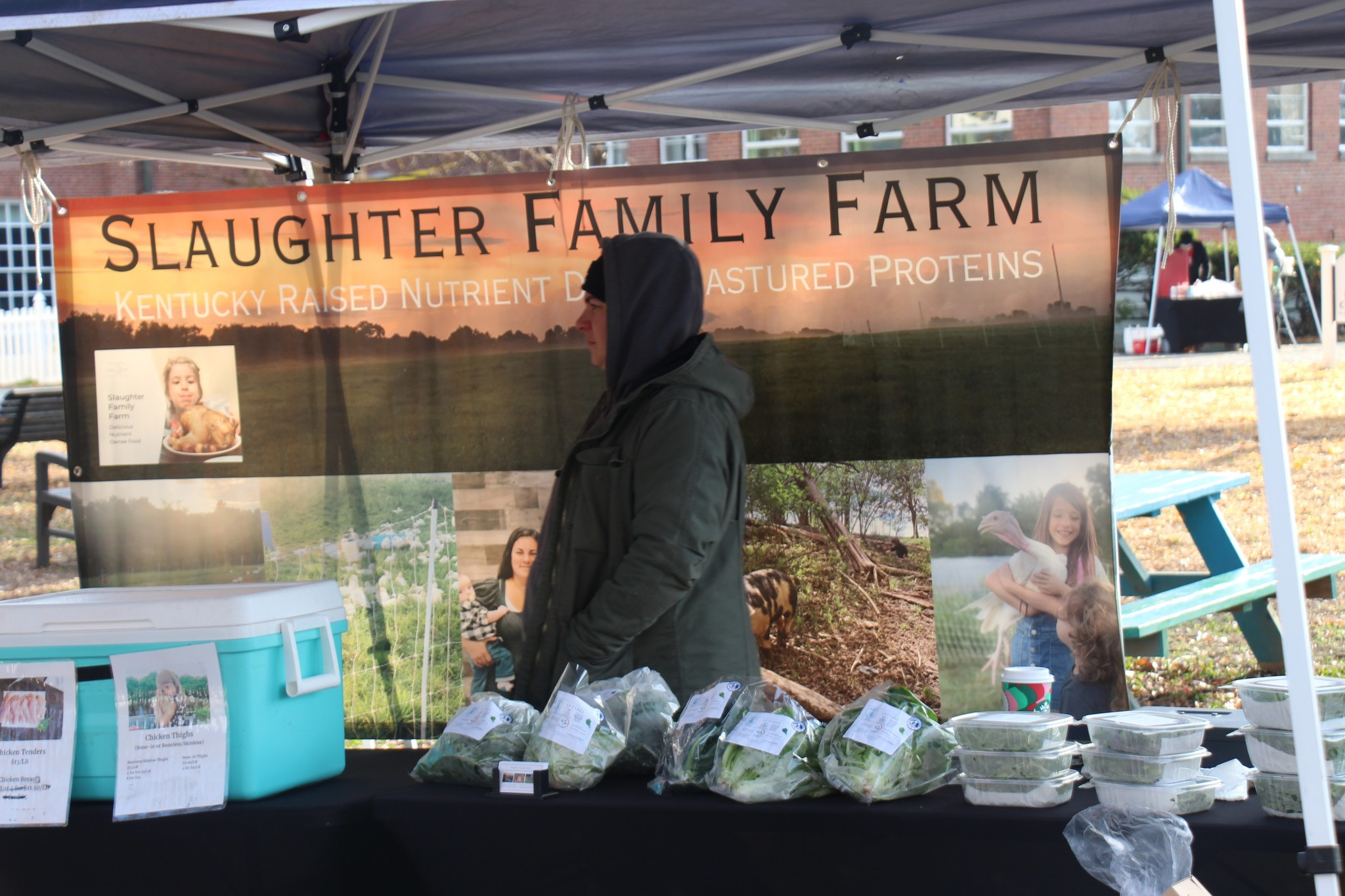Pastured Poultry Challenges and Solutions
posted on
September 3, 2024

Pastured Poultry is an extremely seasonal endeavor. Chickens, unlike waterfowl or turkeys, are very sensitive to weather conditions. Chickens can succumb to a variety of weather related losses or predation losses. This is why many pastured poultry producers utilize schooners or chicken tractors to keep their poultry out of the elements, while still enjoying the benefits of chickens on grass and sunlight.
We utilized chicken tractors our first two years of production before switching to open sided shelters and poultry netting that allows us to move our poultry at a much quicker clip along the pasture. It also gives our broiler chickens a larger area to scratch, forage for plant and insect varieties, sunbathe, and express their chicken-ness.
The change in chicken rearing allowed us to move a lot more chicken feet across the same acre(s) of land without causing irreversible or expensive damage to our pastures. Because of this, we were able to expand our business beyond anything that we imagined possible.
Even with these changes and the increase in production, we still run into many challenges for which we have found solutions moving into the tail end of the 2024 season and for the foreseeable future.
Challenge #1: Lack of USDA Processing
USDA poultry processing plants are scarce, and many people might assume we have the same capabilities as the major players in the poultry industry—like the brands you find in grocery stores. The chicken industry has invested in multi-million-dollar facilities equipped with robots and other automated systems, enabling efficiencies that smaller USDA plants simply can't afford to offer.
These large processing plants are often owned or controlled by "Big Chicken," making it difficult for small producers like myself and others to access their facilities. Even if many of us farmers banded together, we wouldn't be able to raise enough chickens to compete in this space.
For example, Tyson Foods owns and controls roughly 123 processing plants. In 2023, Tyson laid off 4,200 workers when it closed eight meatpacking plants, six of which were chicken processing facilities. This illustrates the immense scale at which Big Chicken operates. According to a Washington Post article, Tyson Foods invested over $1 billion in automated and robotic technology, allowing them to process over 100,000 chickens per day:

Photo Credit: Agriculture Dive
In contrast, our main poultry processing plant can only harvest 4,000 to 5,000 chickens a day. This disparity is a major reason why it's so challenging to compete with Big Chicken.

When you purchase from us, you're not only supporting the work of our hands but also the work of our butchers and cold storage partners, who pay their employees a livable and equitable wage.
Challenge #2: Hauling Chickens to the Processor
Catching, crating, and hauling chickens consumes a significant portion of our time during late spring, summer, and early fall. Chickens are best caught at night, so we typically begin this task around 10:30 in the evening. After crating the chickens, we load them onto pallets and secure them on our flatbed trailer and truck. I then get about an hour of sleep before waking up at 3:30 a.m. to haul our birds to the processor.
After dropping off the chickens, I usually head to cold storage to pick up a pallet of chicken before making the 3-hour-and-30-minute drive back home. Once home, we unload and inventory the chicken products. These hauling days easily turn into 20-hour workdays, and we do this every eight weeks.

Challenge #3: Labor Costs
As many of you know, pastured poultry farming requires a significant amount of labor. Every morning, we gather feed from our grain silo, move our shelters and water systems, and feed the chickens. Every few days, we also take down and set up our poultry netting (which keeps our birds safe from ground predators) and move our energizers.
While we've developed our own efficiencies within our model, they still pale in comparison to the large indoor chicken houses. The industry raises their birds in vast buildings with silos that automatically funnel feed into the chickens' feeders. Their water systems are plumbed in, eliminating the need for the labor required to move shelters, netting, feeders, or waterers. Birds in this system can be raised year-round, 24/7, 365 days a year:

Photo Credit: The Equation (Tyson Chicken House)
Pastured poultry raising and butchering can be an extremely seasonal job, leading to layoffs during the winter months. This creates a dilemma for many pastured poultry producers who don't live and work in more temperate climates.
We've considered hiring a farmhand, but I struggled with how to pay them well enough to live on while also providing enough work during the winter months to justify the hire.
Challenge #4: Seasonality
I may be belaboring the point, but here in Kentucky, we face weather-related challenges that make raising pastured poultry year-round problematic. Kentucky can experience all four seasons in one week, sometimes displaying weather patterns we didn't even know existed.
In the past, the only way to sell poultry in the winter and keep our doors open was to raise double the amount in the spring and summer. While we've extended our season somewhat, birds raised in late fall require more feed and labor to reach ideal butcher weight due to fluctuating temperatures.
Storing chicken for winter sales presents a myriad of challenges:
1. Some chicken cuts end up older than we’d prefer.
2. Additional freezer space and expensive energy costs.
3. Cash flow issues.
For example, if I know I’m only selling a certain amount of chicken per month but need to raise more to get through the winter, this creates a cash flow issue because I won’t see the gross income on a portion of the chicken raised, fed, butchered, and paid for until several weeks or months later.
We've considered selling poultry only from May to September but knew that this choice would alienate a large portion of our customers and eventually force us to close our doors.
These challenges are why many pastured poultry businesses struggle to provide a full-time income. According to the American Farm Bureau Federation, 141,733 small farms closed their doors between 2017 and 2022. In 2022, many Kentucky farms averaged gross sales between $1,000 and $99,000 annually—neither of which would allow most families or individuals to farm full-time.*
*These numbers and figures are based on conventional agriculture, not regenerative agriculture.
We would prefer not to become one of these statistics. That’s why we've made some well-thought-out decisions to address our poultry challenges.
Solution #1: Processing Partners
King and Sons Poultry Services, Inc., located in Ohio, has been our primary poultry processor since 2020. We’re grateful to have King and Sons as a reliable processor. They do an excellent job, and we will continue to use them for 80-90% of our poultry next season.
We’re also working on setting up processing dates with a newly opened USDA processor in Morehead, KY. While they’re much smaller compared to King and Sons, this will give us another option for butchery and help ensure that our whole chickens stay in stock.

Photo Credit: Sugarloaf Mountain Meats (Moorehead, KY)
In addition to Sugar Loaf Mountain Meats, we will also have dates with two other USDA processors. One ran by the Amish in Pembroke, KY and another in Tennessee.
Solution #2: Farm Partners
Starting next season, we’ll be hiring a young Amish family to raise every third batch of broiler chickens for us. They will raise our birds to our specifications: 100% free-range, GMO-free, and hormone and antibiotic-free. We’re hopeful that this partnership will provide a full-time living for this family.
We’re also in conversations with a few friends who have modest amounts of land about allowing their kids to raise a few batches of chickens for us. The hope is to give them an extra skill they can carry with them through life.
Solution #3: Winter Growing Practice and Collaborations
Starting this December, we will begin raising chickens year-round. Part of the way we’ll do this is by utilizing our heated high tunnel. Our chickens will have consistent access to heat and water inside their high tunnel housing. In the morning, we’ll open the high tunnel doors and feed the chickens outside, allowing them to free-range where their food is while also having the option to warm themselves in the high tunnel when temperatures are less desirable.

Photo Credit: Slaughter Family Farm (High Tunnel and Woodlot Paddocks in Background)
Essentially, this system will be similar to our spring, summer, and fall setup, except the shelter will be static, and we’ll rotate the birds around it.
With the extension of our poultry season, we’ll also be wholesaling certain cuts from our butcher, King and Sons. This collaboration will allow us to keep chicken cuts that we don’t sell as frequently in stock year-round.
These cuts will include:
1. Chicken Drumsticks
2. Whole Chicken Wings (Not Party Wings)
3. Chicken Patties
4. Apple Chicken Bratwurst
5. Cheddar Cheese Chicken Bratwurst
6. Cheddar Jalapeño Chicken Bratwurst
7. Split Chicken Breast (available January-March only)
These items will be available exclusively through our webstore and will not be sold at any of our farmers' market locations, wholesale partners, CSA subscriptions, or buying club memberships (unless requested).
This year, due to the increased demand for our ground chicken, we produced only one batch of chicken drumsticks for retail. Moving forward, all of our pastured chicken drumsticks and whole wings (not party wings) will be processed in bulk for our wholesale partners. If you’re a customer who would like pastured whole wings or drumsticks, you may purchase them from us in bulk at wholesale pricing (while supplies last).
Why King and Sons?
King and Sons have been instrumental in the growth of our chicken business. They are very like-minded and supportive of the farms that utilize their butcher services.
The products produced by King and Sons for us will adhere to the same protocols we follow when moving our hens to winter housing:
Always Non-GMO fed
Antibiotic- and Drug-Free
No Added Hormones
Direct Sunlight in Winter Housing
Transparency: How Do I Know What Is What?
Our free-roaming, pasture-raised poultry is produced from early April until early December. Our winter high tunnel birds will be raised from late December until mid-March. King and Sons will only supply us with the cuts mentioned above, and these will be noted as such on our website.
Only our free-roaming, pasture-raised products will go to our wholesale partners, CSA members, farmers' markets, and buying club members. Our winter high tunnel birds will be sold on our website only in February and March. These winter high tunnel birds will also be used as free products for subscribe-and-save customers.
If you have any questions about our animal husbandry practices please reach out!
We appreciate each and every one of you!
Thank you for allowing us to feed your family.
Your Farmer,
Justin Slaughter



